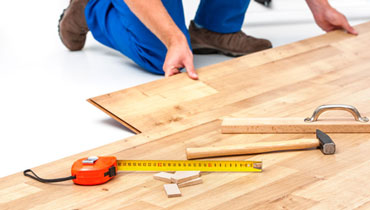Monday - Friday 07:30 - 17:30, Saturday 07:30 - 16:00
Expert Floor Fitting Services in London

Elevate your living or working space with the timeless elegance of wood floors. Our dedicated team specialises in expert wood floor laying services, offering precision installation to enhance the beauty and functionality of your property. Whether you're revitalizing your home or giving a commercial space a sophisticated touch, our professionals are committed to delivering impeccable wood floor installation that meets your unique needs. Discover the transformation that expertly installed wood floors can bring to your London property.
Detailed Preparation for Perfect Installation
Perfect wood installation requires detailed preparation, which involves leveling subfloors, dust control, and managing moisture, dampness, and soundproofing. The next step is to choose the right method of fitting, whether it’s engineered or solid wood, parquet, or laminate. We pay attention to every detail, including often-neglected tasks like door frame trimming.
Comprehensive Pre-Installation Tasks
Before starting with the installation of the planks, there are a few critical tasks we undertake. If you think our job is simply laying timbers, you're mistaken! Our first job is to properly clean the dusty subfloor since dust can create uneven surfaces and cause unsteady flooring. Dust can also react with the adhesive, posing problems for the fitting service. Although we use advanced dust-free systems and equipment, we think ahead and protect other rooms and furniture.
Managing Moisture Levels
An important step in the process is checking the moisture level, especially with London's climate. Moisture damage can be mitigated by ensuring a clean and dry subfloor, installing a damp-proof membrane, and making sure pipes are in good condition. Additionally, we allow time for the flooring to adjust to the temperature and humidity.
Preparing for Installation
Once these preliminary steps are completed, our staff meticulously prepares for the installation by addressing one of the often-overlooked yet crucial aspects: the doors. Our team carefully removes the doors to ensure they remain in perfect condition throughout the installation process. This attention to detail prevents any potential damage to the doors, which can occur if they are left in place during the installation.
Applying Underlay for Optimal Results
The final step is to apply underlay, which serves specific functions such as sound insulation or creating a solid and even base. Underlay is often combined with engineered wood or laminate in what is known as a floating installation. Floating floor planks fit together like puzzle pieces without the need for gluing or nailing.
Discover the difference expert installation can make in your space. Trust our team to deliver exceptional results that enhance both the aesthetics and functionality of your property.
Floor Installation Process
Our floor installation process is designed to deliver exceptional results while minimising disruption to your daily routine. We follow a systematic approach to ensure each step is executed with precision and care.
- Detailed Site Preparation
Before installation begins, our team conducts a thorough assessment of the site. This includes ensuring the subfloor is level, clean, and dry. Any necessary adjustments, such as door frame trimming and moisture barrier installation, are completed to create a perfect foundation for your new floor.
- Accurate Measurement and Layout
We measure and plan the layout of the flooring to ensure a seamless fit. This step involves selecting the starting point and direction of the installation to optimise the aesthetic appeal and functionality of the space.
- Precise Cutting and Fitting
Using advanced tools and techniques, our skilled technicians cut the flooring materials to the exact dimensions required. Whether installing solid wood, engineered wood, parquet, or laminate, we ensure each piece fits perfectly, maintaining the integrity of the pattern and design.
- Secure Installation
We employ the appropriate method of installation based on the type of flooring. This could include nailing, gluing, or floating techniques. Our experts ensure each plank or tile is securely fitted, avoiding gaps and ensuring stability.
- Finishing Touches
After the main installation is complete, we focus on the finishing touches. This includes sanding, staining, and applying protective finishes if necessary. These steps enhance the beauty and durability of your new floor, ensuring it withstands daily wear and tear.
- Final Inspection and Clean-Up
Once the installation is finished, we conduct a thorough inspection to ensure every aspect meets our high standards of quality. We clean up the site, removing any debris and ensuring your space is ready for use.
Our commitment to excellence ensures that your floor installation process is smooth, and efficient, and delivers stunning results that enhance the beauty and functionality of your space.
Contact us now to start planning your perfect floors. Call today at 020 70360625 to turn your flooring dreams into a beautiful reality!









































